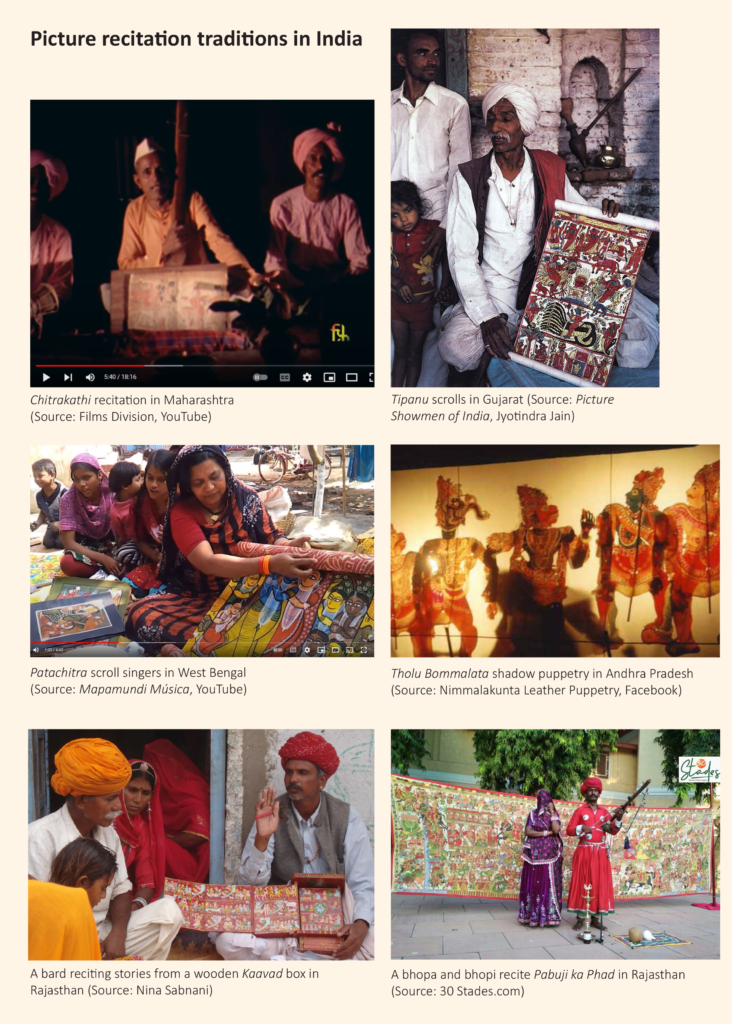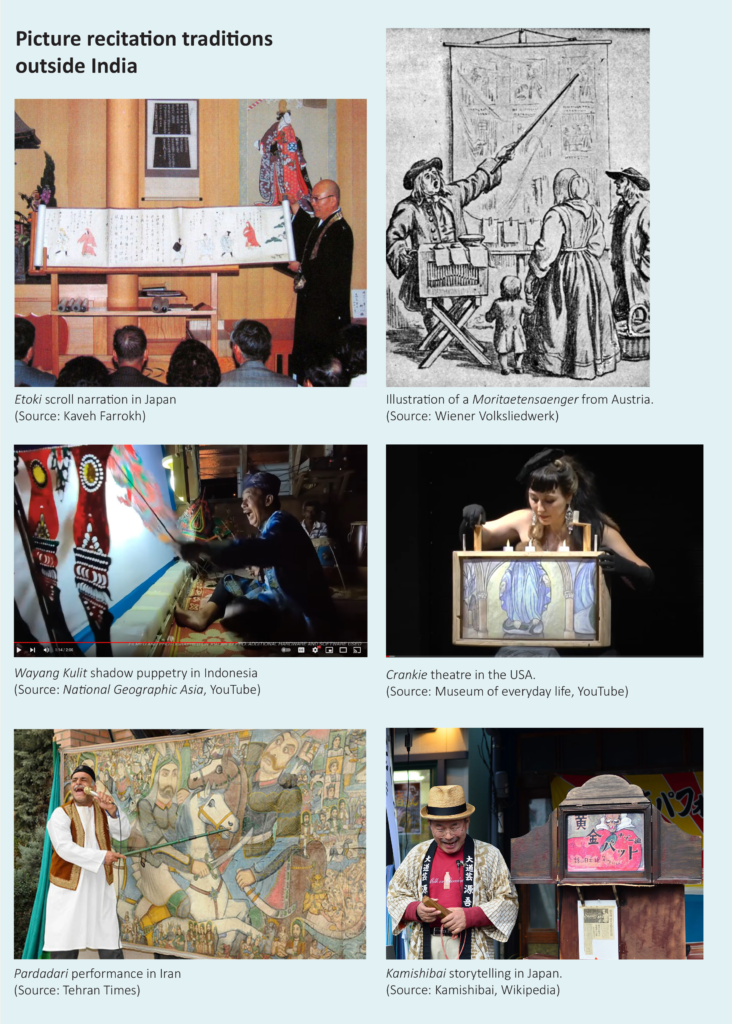Picture Recitation

This page provides information about the current practices of picture recitation in India. Picture recitation is the art of telling stories in poetic verses and songs by using visual props in which images related to the stories are illustrated. The earliest reference to picture recitation in India are found in a grammatical treatise written between 160 and 140 BCE and again in a play written in the sixth century CE, where a storyteller of Yama Pata (scrolls depicting rewards and punishments being meted out in the kingdom of Yama, the Hindu god of death) is employed as a royal spy [Mair VH (1988) Painting and performance: Chinese picture recitation and its Indian genesis. University of Hawaii Press, Honolulu].

Various types of picture recitations are practiced in many parts of India and they are mentioned in the book Picture Showmen: Picture Showmen: Insights Into the Narrative Tradition in Indian Art by Jyotindra Jain (Marg Publications, 1998). Picture recitation is however difficult to witness as there is no popular platform where these practices can be viewed on a regular basis. Some artists put up stallls in Dilli Haat a craft bazaar in New Delhi, the capital of India. Here is some information about how one can access, meet the artists, view performances and buy artworks related to these practices.
Patachitra of West Bengal
Patachitra are scrolls painted with organic colours on paper. The artists making them are called Patachitrakar and they are mostly located in the villages of Naya and Pingla in West Bengal. A 3-day festival of this art form called Pot Maya is celebrated annually.
More info here:https://bengalpatachitra.com/festival/
https://www.midnapore.in/festival/potmaya/pot-maya-naya-pingla.html
Bangla Natak is a social enterprise that works with the Patachitra artists who can help visitors access these artforms. Visit their website https://banglanatak.com/home
Kaavad of Rajasthan
Kaavads (also spelt Kavad) are small wooden boxes with doors made of multiple hinged panels painted on both sides with images from stories. The panels are opened and stories recited. Nina Sabnani had written the book Kaavad Tradition Of Rajasthan: A Portable Pilgrimage on this practice which is available online.
The artists making the Kaavads reside in Bassi village near Chittorgarh in Rajasthan.
More info here: Kavad Art: Bassi and Beyond
https://gaatha.org/Craft-of-India/traditional-story-telling-kavad/
Kaavads are considered portable temples carried from village to village by a group of people called Bhatt who recite its stories.
One of its artists Dwarka Prasad Jangid has been awarded a medal of honour for illustrating a contemporary story about girl child education called Meena ki Kahani (The Story of Meena).
Phad of Rajasthan
Phad is a long tapestry painted by hand which is used for recitation of stories of local folk heroes and deities such as Pabuji and Devnarayanji in Rajasthan. John D Smith has detailed the recitation of this form along with the lyrics in his book Pabuji ka Phad (Cambridge University Press, 1991). Phad recitation last throughout the night ending at dawn in which the long tapestry are stretched between bamboo poles and the images are illuminated by the flame of a lamp in the darkness of the night. The recitation is done by singers called Bhopas.
More info here: The Vibrant World of Phad Paintings: A Window into Rajasthan’s Rich Culture
Chitrakathi of Maharashtra
The artists of Chitrakathi are called Chitrakathikar and they practice in the villages of Maharashtra-Karnataka region auch as Paithan, Pinguli and Sindhudurg. At Pinguli, Parashuram Gangawane (a Padmashree awardee by the Govt. of India) and his family are Chitrakathi artists from the Thakar community who are continuing this ancient art form of story telling using old pothis, puppets, musical instruments and also innovating with contemporary interpretations. The Thakar community is said to have worked as spies for Chhatrapati Shivaji while travelling as storytellers. The Gangawane family have opened a museum, the Thakar Aadiwasi Kala Aangan Museum and Art Gallery and conduct shows at their museum. (Source: https://deccanviews.wordpress.com/category/chitrakathi/)
More info here: https://artsandculture.google.com/story/old-chitrakathi-art-dastkari-haat-samiti/kwXhwLREm72yKQ?hl=en
Website of the Thakar Aadiwasi Kala Aangan Museum and Art Gallery: https://pingulichitrakathiart.com/
Zapurza Museum of Art and Culture in Pune has a large collection of Chitrakathi (see their Facebook page) which the museum curator Mr. Raju Suthar can elucidate upon.
Tholu Bommalata shadow puppetry of Andhra Pradesh
Sindhe Chithambara Rao is a National Award-winning puppeteer from Dharmavaram village in the Anantapur district of Andhra Pradesh. He performs with his wife, two older brothers and three nephews. Their troupe is called Chaya Nataka Brundam.
More info: https://sarmaya.in/objects/indigenous-tribal-art/hanuman-and-lankini-tholu-bommalata/
Kaavad Katha by Akshay Gandhi, Bangalore
Kaavad Katha is a project developed by Akshay Gandhi to revive the dying tradition of Kaavad. Akshay, a theatre actor and director, trained under a Kaavad Bhatt to learn the art of recitation and collaborated with urban artists to create a Kaavad prop with a contemporary story.
More info on the website: Kaavad Katha